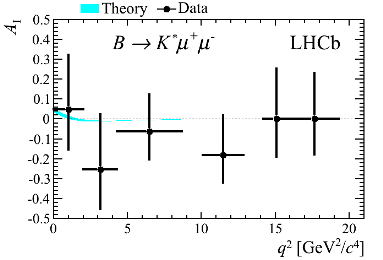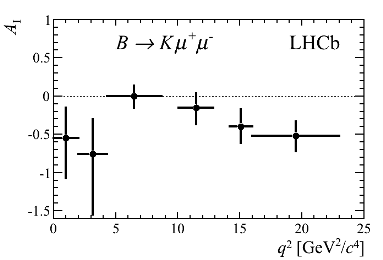The decay of the beauty meson B into an excited K meson K* and a μ+ and μ– pair is considered as an important channel for new physics search, see 13 March 2012 and 22 July 2011 news. Different distributions and branching fractions have been studied for these B meson decays and compared with the Standard Model predictions. Recently LHCb physicists have studied in addition the differences in the results of measurements of neutral B meson decays into K*0μ+μ– and charged B+ meson decays into K*+μ+μ–. Theoretical uncertainties of the Standard Model calculations are strongly reduced in these differences. Physicists call these differences “asymmetries” and since this case involves differences between the decays of particles with different charges, it is called an “isospin asymmetry” AI. The Standard Model calculations predict this isospin asymmetry to be small, as shown with the help of the color line in the left image below, where the prediction is presented as a function of the square of the di-muon invariant mass (q2). The experimentally measured distribution, shown by points with error bars, is consistent with this prediction.
click the image for higher resolution
A surprise came when the physicists made similar analysis by replacing the excited kaon K* by its ground state K. The negative asymmetry is clearly visible in the right image above (4.4σ different from zero after integration (summation) over the whole q2 region). The Standard Model calculation is not yet available for this asymmetry, but is, as in the Bs→K*μμ mode, expected to be very close to zero.
The images shown above were obtained with the full 2011 data sample. These results have been made possible by the strong and continuous support from the LHC operations team for the LHCb physics program, and the data sample is expected to more than double by the end of this year. In the meantime theorists will analyze this puzzling result in order to establish whether this effect can be accommodated in the framework of the Standard Model, or whether a new physics explanation is required.
Read more in CERN Bulletin article in English and French, in the CERN Courier article and LHCb publication.


